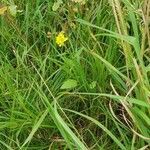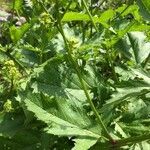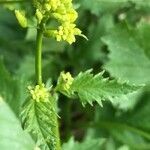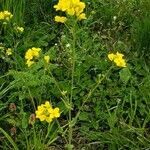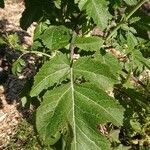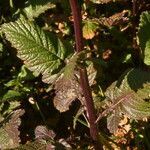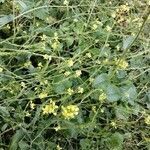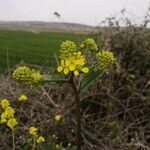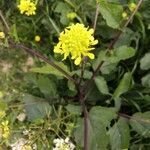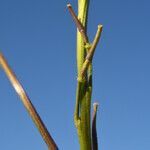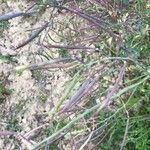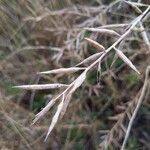Annuals; sparsely to densely hirsute-hispid (at least basally, proximally rarely subglabrate). Stems usually branched distally, (widely spreading), 3-20 dm. Basal leaves: petiole to 10 cm; blade lyrate-pinnatifid to sinuate-lobed, 6-30 cm × 10-100 mm, lobes 1-3 each side, (smaller than terminal, terminal lobe ovate, obtuse). Cauline leaves sessile or subsessile; blade (ovate-elliptic to lanceolate, similar to basal, reduced distally and less divided), base tapered, not auriculate or amplexicaul, (margins entire to sinuate-serrate). Racemes not paniculately branched. Fruiting pedicels erect (straight), (2-)3-5(-6) mm. Flowers: sepals 4-6(-7) × 1-1.5 mm; petals yellow, ovate, 7-11(-13) × (2.5-)3-4.5(-5.5) mm, claw 3-6 mm, apex rounded; filaments 3.5-5 mm; anthers 1-1.5 mm. Fruits erect-ascending (± appressed to rachis), smooth, ± 4-angled, 1-2.5(-2.7) cm × (1.5-) 2-3(-4) mm; valvular segment 2-5(-8)-seeded per locule, (0.4-)0.8-2(-2.5) cm, terminal segment seedless (linear, narrow), (1-)2-5(-6) mm. Seeds brown to black, 1.2-1.5(-2) mm diam.; seed coat coarsely reticulate, minutely alveolate, not mucilaginous when wetted. 2n = 16.
Annual herb with lax rosette. Stems erect, glabrous above, bristly below, ribbed, 0.6-1-(2) m tall. Lvs green, petiolate, sparsely bristly. Lower lvs lyrate-pinnatifid, to 16 cm long; margins dentate; terminal lobe large, 3-lobed to ovate; lateral lobes subacute, in 1-2 pairs. Upper stem lvs not lobed, becoming entire, lanceolate, 3-5 × 0.5-1 cm. Racemes to 40 cm long; buds overtopping or level with open fls. Sepals narrow-oblong, 3-4 × c. 1 mm. Petals bright yellow, 7-8 × 2-3 mm. All stamens erect. Silique quadrangular, glabrous, oblong, appressed to rachis, somewhat constricted between seeds, (6)-12-25 × 2 mm; gynophore 0; valves strongly keeled, with prominent median and weak lateral veins; beak slender, seedless, (1.5)-2-4 mm long. Seeds red-brown, c. 1 mm diam.
Annual herb; taproot slender; stem erect, to 1 m tall, branched, thin, usually with anthocyanin spot in axil, hispid below, glaucous and glabrous above. Leaves petiolate; lower leaves lyrate-pinnatifid, to 16 cm long, the terminal lobe large, lateral lobes of 1–3 pairs, hispid both sides; upper leaves lanceolate, entire, glabrous, glaucescent. Inflorescence sub-corymbose. Sepals 4–5 mm long, half-spreading. Petals 7–9 mm long, bright yellow. Ovary sessile. Siliqua 1–2 cm long, 1.5–2 mm wide, quadrangular, erect-appressed; valves with prominent midrib; beak seedless, 1.5–3 mm long. Seeds 1.5 mm wide, 2–5 per locule, dark red-brown.
A cabbage family herb. It is an annual plant. It grows about 1-3 m high. The leaves are stalked and clasp the stem. The upper leaves are sword shaped. Leaves are 10-20 cm long. Flowers are yellow. The fruit is a pod. It is erect, smooth and 2 cm long. It can have 3-5 seeds. The seeds are reddish-brown to almost black. They are 1.5 mm across.
